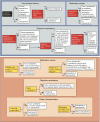The treatment landscape in thyroid cancer: a focus on cabozantinib
- PMID: 26316818
- PMCID: PMC4547654
- DOI: 10.2147/CMAR.S68373
The treatment landscape in thyroid cancer: a focus on cabozantinib
Abstract
Although patients with thyroid cancer generally fare well, there is a subset for which this is not necessarily true. Progress in understanding the molecular aberrations in thyroid cancer has led to a change in the management of these cases. Since 2011, four multikinase inhibitors (MKIs) have been approved by the US Food and Drug Administration for thyroid cancer - cabozantinib and vandetanib for medullary thyroid cancer and sorafenib and lenvatinib for differentiated thyroid cancer. This change in the treatment landscape has raised challenges for practitioners who may not be familiar with the use of MKIs or with the treatment and natural history of advanced thyroid cancer in general. This article reviews the epidemiology, molecular drivers, and initial treatment of patients with thyroid cancer and offers practical guidance to assist with the determination of when to appropriately start an MKI. As an example, cabozantinib and its efficacy are discussed in detail. Close monitoring is required for all patients on targeted agents to assess for adverse effects and response to therapy. An approach to managing drug-related adverse events is detailed. Since these drugs are not curative and have not yet proven to prolong overall survival, it is critical to weigh the risks and benefits of treatment at every visit. The potential value of changing to a different agent following failure of an MKI is also addressed.
Keywords: RET; VEGF; adverse event; chemotherapy; kinase inhibitor; targeted therapy.
Figures






Similar articles
-
Multikinase Inhibitor Treatment in Thyroid Cancer.Int J Mol Sci. 2019 Dec 18;21(1):10. doi: 10.3390/ijms21010010. Int J Mol Sci. 2019. PMID: 31861373 Free PMC article. Review.
-
Current perspectives on the management of patients with advanced RET-driven thyroid cancer in Europe.Front Oncol. 2023 May 3;13:1141314. doi: 10.3389/fonc.2023.1141314. eCollection 2023. Front Oncol. 2023. PMID: 37207147 Free PMC article. Review.
-
Management of treatment-related toxicities in advanced medullary thyroid cancer.Cancer Treat Rev. 2018 May;66:64-73. doi: 10.1016/j.ctrv.2018.04.007. Epub 2018 Apr 22. Cancer Treat Rev. 2018. PMID: 29704768 Review.
-
Advances in small molecule therapy for treating metastatic thyroid cancer.Expert Opin Pharmacother. 2017 Aug;18(11):1049-1060. doi: 10.1080/14656566.2017.1340939. Epub 2017 Jul 3. Expert Opin Pharmacother. 2017. PMID: 28602103 Review.
-
Update on multikinase inhibitor therapy for differentiated thyroid cancer.Drugs Today (Barc). 2018 Sep;54(9):535-545. doi: 10.1358/dot.2018.54.9.2878150. Drugs Today (Barc). 2018. PMID: 30303494 Review.
Cited by
-
Novel Therapeutics in Radioactive Iodine-Resistant Thyroid Cancer.Front Endocrinol (Lausanne). 2021 Jul 15;12:720723. doi: 10.3389/fendo.2021.720723. eCollection 2021. Front Endocrinol (Lausanne). 2021. PMID: 34335481 Free PMC article. Review.
-
Practical management of adverse events associated with cabozantinib treatment in patients with renal-cell carcinoma.Onco Targets Ther. 2017 Oct 19;10:5053-5064. doi: 10.2147/OTT.S145295. eCollection 2017. Onco Targets Ther. 2017. PMID: 29089775 Free PMC article. Review.
-
Medullary thyroid carcinoma: recent advances in identification, treatment, and prognosis.Ther Adv Endocrinol Metab. 2021 Oct 8;12:20420188211049611. doi: 10.1177/20420188211049611. eCollection 2021. Ther Adv Endocrinol Metab. 2021. PMID: 34659736 Free PMC article. Review.
-
Decoding kinase-adverse event associations for small molecule kinase inhibitors.Nat Commun. 2022 Jul 27;13(1):4349. doi: 10.1038/s41467-022-32033-5. Nat Commun. 2022. PMID: 35896580 Free PMC article.
-
Medullary thyroid carcinoma - Adverse events during systemic treatment: risk-benefit ratio.Arch Endocrinol Metab. 2017 Jul-Aug;61(4):398-402. doi: 10.1590/2359-3997000000267. Epub 2017 Jun 26. Arch Endocrinol Metab. 2017. PMID: 28658345 Free PMC article. Review.
References
-
- COMETRIQ™ [package insert] South San Francisco, CA: Exelixis, Inc.; 2012. [Accessed March 29, 2015]. Available from: http://www.cometriq.com/downloads/Cometriq_Full_Prescribing_Information.pdf.
-
- National Cancer Institute at the National Institutes of Health . Cancer of the Thyroid – SEER Stat Fact Sheets. Bethesda, MD: National Cancer Institute at the National Institutes of Health; [Accessed March 27, 2015]. Available from: http://seer.cancer.gov/statfacts/html/thyro.html.
-
- Ruegemer JJ, Hay ID, Bergstralh EJ, Ryan JJ, Offord KP, Gorman CA. Distant metastases in differentiated thyroid carcinoma: a multivariate analysis of prognostic variables. J Clin Endocrinol Metab. 1988;67(3):501–508. - PubMed
-
- Besic N, Gazic B. Sites of metastases of anaplastic thyroid carcinoma: autopsy findings in 45 cases from a single institution. Thyroid. 2013;23(6):709–713. - PubMed
Publication types
Grants and funding
LinkOut - more resources
Full Text Sources
Research Materials

